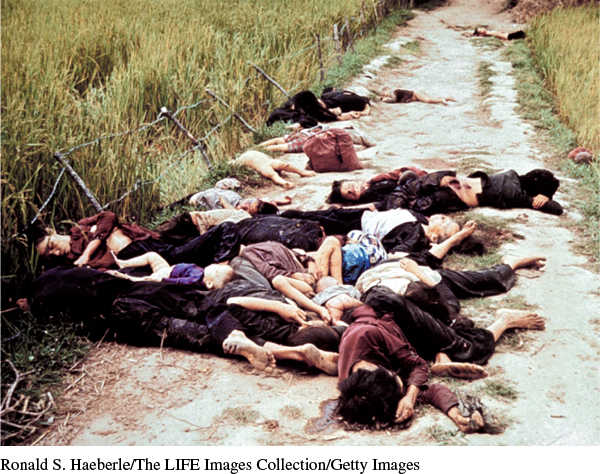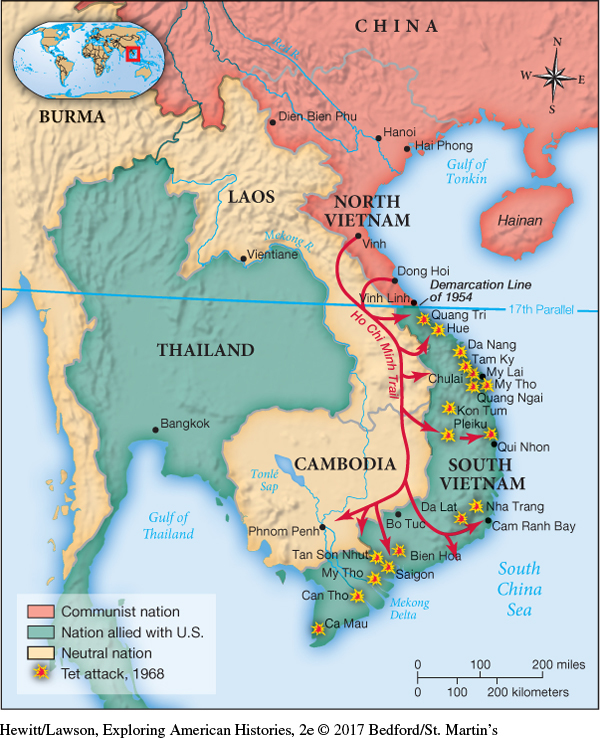Johnson Escalates the War in Vietnam
When Lyndon Johnson took office after Kennedy’s assassination, there were 16,000 American military advisers in Vietnam. Privately, Johnson harbored reservations about fighting in Vietnam, but he feared appearing soft on communism and was concerned that a demonstration of weakness would jeopardize congressional support for his domestic plans. Although Johnson eventually concluded that more U.S. forces had to be sent to Vietnam, he waited for the right moment to rally Congress and the American public behind an escalation of the war.
That moment came in August 1964. On August 2, North Vietnamese gunboats attacked an American spy ship sixty miles off the North Vietnamese coast in the Gulf of Tonkin. Two days later, another U.S. destroyer reported coming under torpedo attack, but because of stormy weather the second ship was not certain that it had been fired on. Neither ship suffered any damage. Despite the considerable uncertainty about what actually happened with the second ship, Johnson seized the opportunity to urge Congress to authorize military action. On August 7 Congress passed the Gulf of Tonkin Resolution, which provided the president with unlimited power to make military decisions regarding Vietnam.
After winning election in 1964, President Johnson stepped up U.S. military action. In March 1965, with North Vietnamese forces flooding into the South, the president initiated a massive bombing campaign called Operation Rolling Thunder. For more than three years, American planes dropped a million tons of bombs on North Vietnam, more than the total amount the United States used in World War II. Despite this massive firepower, the operation proved ineffective. A largely agricultural country, North Vietnam did not have the type of industrial targets best suited for air attacks. It stored its vital military resources underground and was able to reconstruct rudimentary bridges and roads to maintain the flow of troops into the South within hours after U.S. bombers had pounded them.
Responding to the need to protect American air bases and the persistent ineffectiveness of the South Vietnamese military, Johnson deployed ever-increasing numbers of ground troops to Vietnam. Troop levels rose from 16,000 in 1963, to 380,000 in 1966, 485,000 in 1967, and 536,000 in 1968. The U.S. military also deployed napalm bombs, which spewed burning jellied gasoline, and Agent Orange, a chemical that denuded the Vietnamese countryside and produced long-term adverse health effects for those who came in contact with it, including American soldiers. These attacks added to the resentment of South Vietnamese peasants and helped the Vietcong gain new recruits.
The United States confronted a challenging guerrilla war in Vietnam. The Vietcong fought at night and blended in during the day as ordinary residents of cities and villages. They did not provide a visible target, and they recruited women and men of all ages, making it difficult for U.S. ground forces to distinguish friend from foe. In the end, the U.S. military effort alienated the population they were designed to safeguard.

On the ground, frustration also bred racism, as many American soldiers could not relate to the Vietnamese way of life and dismissed the enemy as “gooks.” This attitude helped push some troops over the line between legitimate warfare and murder. Frustrated by rising casualties from an enemy they could not see, some American soldiers indiscriminately burned down villages and killed noncombatant civilians. Such contemptible behavior peaked in March 1968 when an American platoon murdered between 347 and 504 unarmed Vietnamese civilians in the village of My Lai, an event that came to be known as the My Lai massacre.
The My Lai carnage came in the wake of the Tet Offensive. On January 31, 1968, the Buddhist New Year of Tet, some 67,000 Communist forces mounted a surprise offensive throughout South Vietnam that targeted major population centers (Map 26.1). For six hours, a suicide squadron of Vietcong surrounded the U.S. Embassy in Saigon. U.S. forces finally repelled the Tet Offensive, but the battle proved psychologically costly to the United States. Following it, the most revered television news anchor of the era, Walter Cronkite of CBS, turned against the war and expressed the doubts of a growing number of viewers when he announced: “To say that we are mired in stalemate seems the only reasonable, yet unsatisfactory conclusion.”

Tet marked the beginning of the end of the war’s escalation. On March 31, 1968, President Johnson ordered a halt to the bombing campaign and called for peace negotiations. He also stunned the nation by announcing that he would not seek reelection. By the time Johnson left the White House in 1969, peace negotiations had stalled and some 36,000 Americans had died in combat, along with 52,000 South Vietnamese troops. The escalation of the war had exacted another high price as well: It created a crisis of public confidence in government and turned many ordinary Americans into dissenters against the political establishment.
REVIEW & RELATE
Why did Kennedy and Johnson escalate the Vietnam War?
How did the reality of the war on the ground compare with the political and military assumptions for fighting it?
Exploring American HistoriesPrinted Page 873
Exploring American Histories Value EditionPrinted Page 646
Chapter Timeline